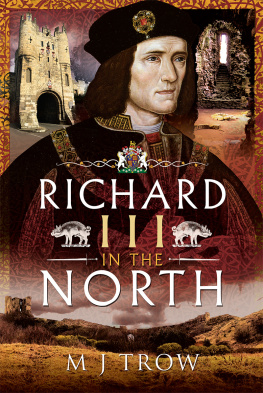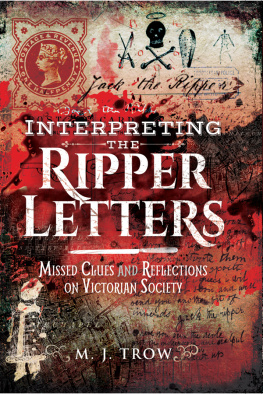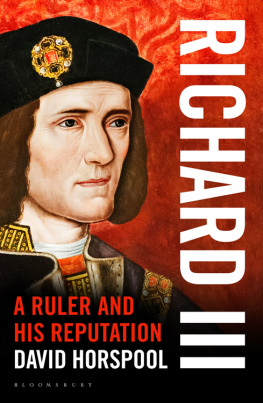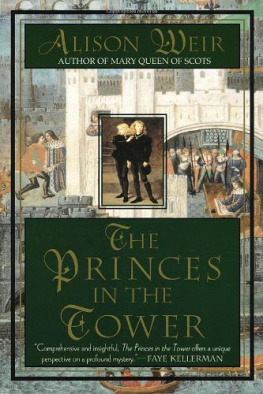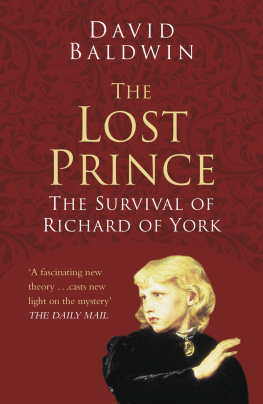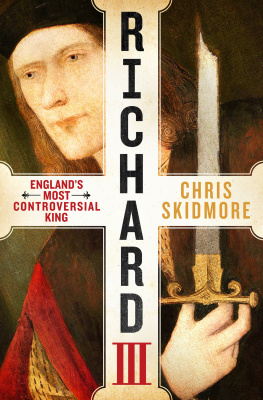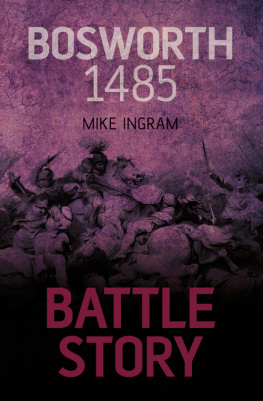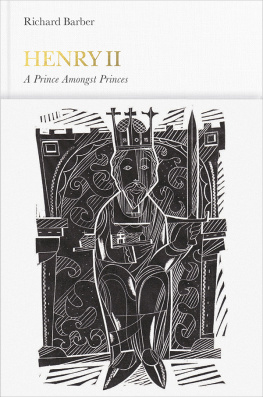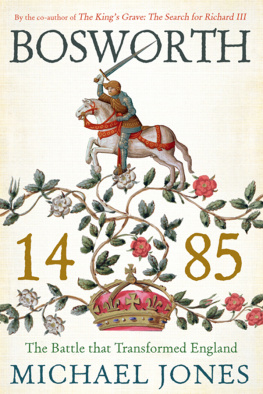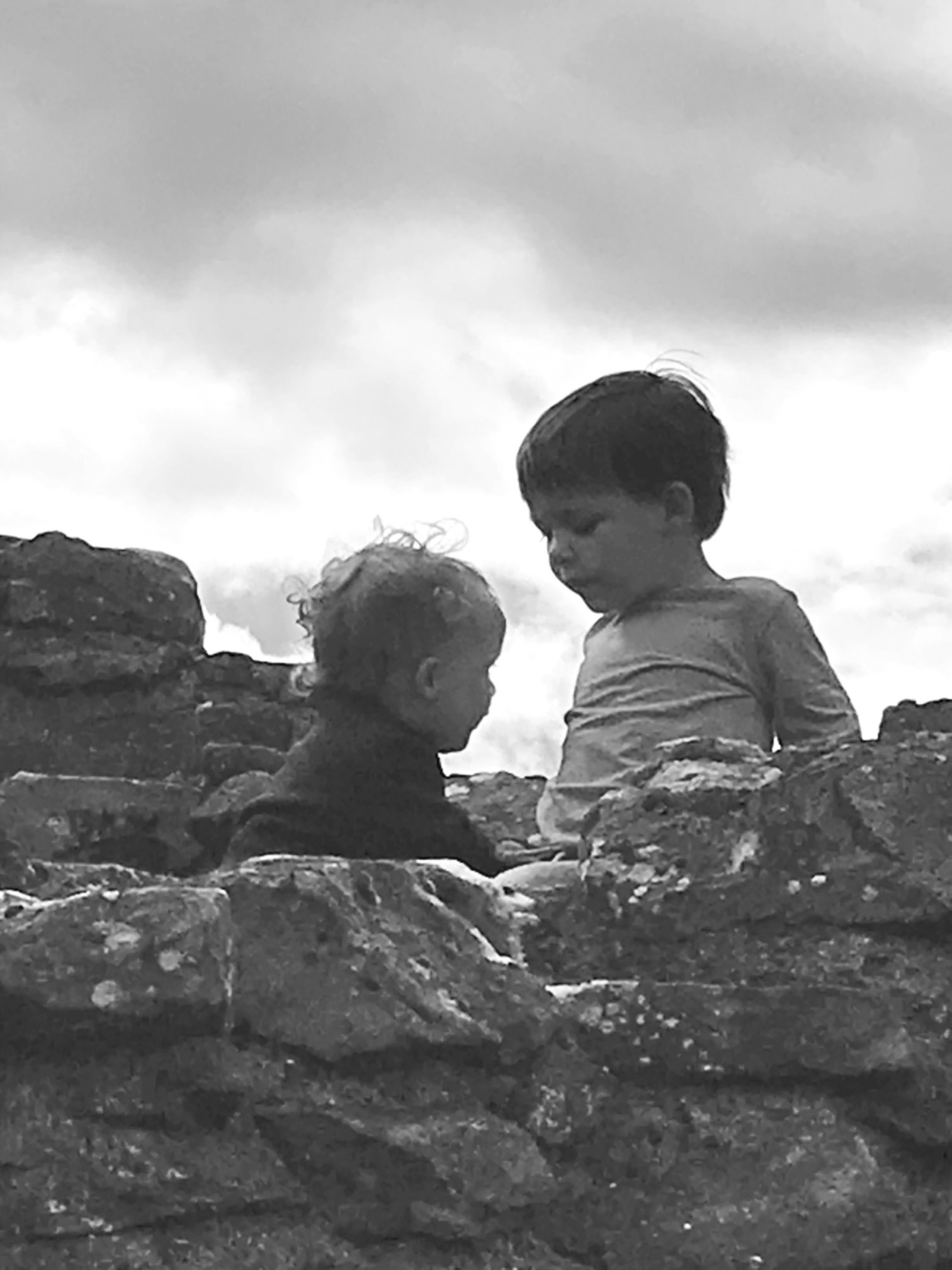Pagebreaks of the print version

RICHARD III IN THE NORTH
To Arthur and Edward, historians of the future!
Our princes in the Brackenbury Tower.
RICHARD III IN THE NORTH
M.J. TROW
First published in Great Britain in 2020 by
PEN AND SWORD HISTORY
An imprint of
Pen & Sword Books Ltd
Yorkshire Philadelphia
Copyright M.J. Trow, 2020
ISBN 978 1 52677 717 1
ePUB ISBN 978 1 52677 718 8
Mobi ISBN 978 1 52677 719 5
The right of M.J. Trow to be identified as Author of
this work has been asserted by him in accordance with the Copyright, Designs and Patents Act 1988.
A CIP catalogue record for this book is available from the British Library.
All rights reserved. No part of this book may be reproduced or transmitted in any form or by any means, electronic or mechanical including photocopying, recording or by any information storage and retrieval system, without permission from the Publisher in writing.
Pen & Sword Books Limited incorporates the imprints of Atlas, Archaeology, Aviation, Discovery, Family History, Fiction, History, Maritime, Military, Military Classics, Politics, Select, Transport, True Crime, Air World, Frontline Publishing, Leo Cooper, Remember When, Seaforth Publishing, The Praetorian Press, Wharncliffe Local History, Wharncliffe Transport, Wharncliffe True Crime and White Owl.
For a complete list of Pen & Sword titles please contact
PEN & SWORD BOOKS LIMITED
47 Church Street, Barnsley, South Yorkshire, S70 2AS, England
E-mail:
Website: www.pen-and-sword.co.uk
Or
PEN AND SWORD BOOKS
1950 Lawrence Rd, Havertown, PA 19083, USA
E-mail:
Website: www.penandswordbooks.com
Authors Note
The North
Geographical terms are relative and in a book like this, charting the life of Richard Plantagenet, the story inevitably travels all over the place. In the fifteenth century, the North meant anywhere north of the River Trent which rises in Biddulph Moor, Staffordshire and flows in a broad crescent shape to Alkborough, where it joins the Humber on its way to Hull and the North Sea.
Acknowledgements
I would like to thank everyone who has helped in the creation of this book, from those who have granted permission to use photographs to those who have been unfailing in their kindness, providing coffee and cake at numerous Richard sites across the North and elsewhere.
I must say thank you to Heather Williams and everyone at Pen and Sword this is a book which I have wanted to write for so long and her enthusiasm on being presented with the project was wonderful.
Above all, and, as always, I want to record my thanks to my wife, Carol. She has always helped with useful critiques of my texts in her capacity as a professional editor, but in this instance has also provided first rate photographs and diagrams and has traipsed with me over some pretty rough terrains in less than kind weather.
Except where otherwise credited, the photographs are copyright Carol Trow. Diagrams of castles and battlefields, maps and heraldic designs are copyright M.J. Trow.
Prologue
Looking for Richard
Nay, which is more and most of all, where is Plantagenet? They are all entombed in the urns and sepulchres of mortality.
Sir Ranulph Crow 1625
I first met Richard III when I was six. It was in the old Majestic cinema in Mill Street, Macclesfield and he was played on screen by Laurence Olivier, complete with hunched back, gammy leg, deformed hand, withered arm and black wig. My mother was a huge Shakespeare fan and when Oliviers Richard was released, we had to go. I can remember the central white tower of the Majestic (still standing) although most of the building has gone, leaving the place in a more ruined state than many of Richards actual castles in the North!
At six, I did not understand much of the storyline. I knew Richard was evil. He hobbled noiselessly around the sets, throwing long, twisted shadows onto doors and walls. His mood changed from gushing sentimentality to ice-cold psychopathy at the turn of a groat. The most terrifying moment came when, lit from below, he turned with hatred on his little nephew (Richard of York, whom he will later kill). The loud discordant crash of music made me jump out of my skin.
I also knew that Henry Tudor, Earl of Richmond was the good guy. He was played by Stanley Baker, whom my mother knew and was, like me, a Welshman. A halo seemed to surround him in all his scenes on the screen. Other than that, I didnt know who anybody was. Thomas Stanley, one of two brothers who ultimately betrayed Richard, was played by Laurence Naismith who, because he was bald, I took for a bishop!
Re-watching the film now, as I have several times over the years, I am struck by how old everybody was. Richard was dead at thirty-three, yet Olivier was fortyeight when he played him. And how could anybody be surprised at the supposedly untimely death of Edward IV when he was played by Cedric Hardwicke, sixtytwo? Of all the credited cast, only Stanley Baker, Claire Bloom, as Anne Neville, Richards queen, and the boys playing the princes in the Tower were the correct ages for the characters they were portraying.
Back in 1956, however, nothing could have prepared me for Richards death at the battle of Bosworth. The setting suddenly changed, from surreal pseudoMedieval sets at Baynards Castle and elsewhere, to rural Leicestershire. This was actually shot in Spain and the harsh sunlight looks hopelessly artificial for England. Having had nightmares in his tent before the battle, Richard regains his sangfroid, muttering the un-Shakespearean Richards himself again, and wheels his white horse to charge against Henry Tudors line. The camera pans with him and Oliviers thunderous Victory sits on our helms! over the galloping hoofs says it all. Music to the ears of a little boy of six!
Then, it all goes horribly wrong. There is a lull in the fighting. Richard yells his completely unhistorical A horse! A horse! My kingdom for a horse! and then he is alone in a hollow, the only sound his breathing as he watches his enemies close in on him. He clashes with Stanley, driving him back with sword and dagger before the Lancastrians surround him, striking and slashing, ripping off his black armour. Then they move back and Olivier, bleeding and in agony, writhes on the ground, that terrible discordant music in effect his death knell.
Rather cornily it seems to me now, the camera focuses on the ribbon of the Garter below his left knee as his body is slung over the back of a horse Honi Soit Qui Mal Y Pense (evil to him who evil thinks) and the crown, which moments before is seen rolling away under horses hoofs, is retrieved in a hawthorn bush and raised to be placed on the head of Henry Richmond. The Tudors have arrived.
Todays filmography provides details a six-year-old would not have been interested in. Olivier directed (he had already played Shakespeares best known villain on stage several times), but he was assisted by an uncredited Alexander Korda, the Hungarian who was more British than the British and made innumerable Empire epics, like The Drum and The Four Feathers . The music was written by William Walton, who also wrote for Oliviers Henry V. Richard III was the first film to be premiered simultaneously in theatres and on television in the States, although British audiences had to go to the pictures for the privilege.

